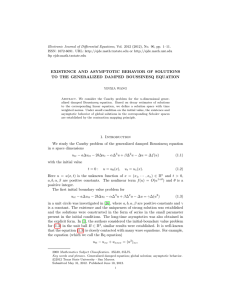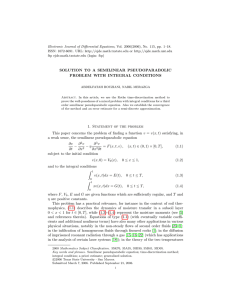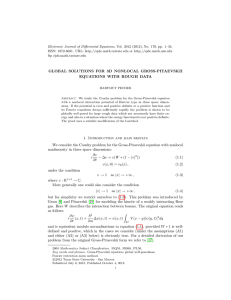Last name: name: 1
advertisement
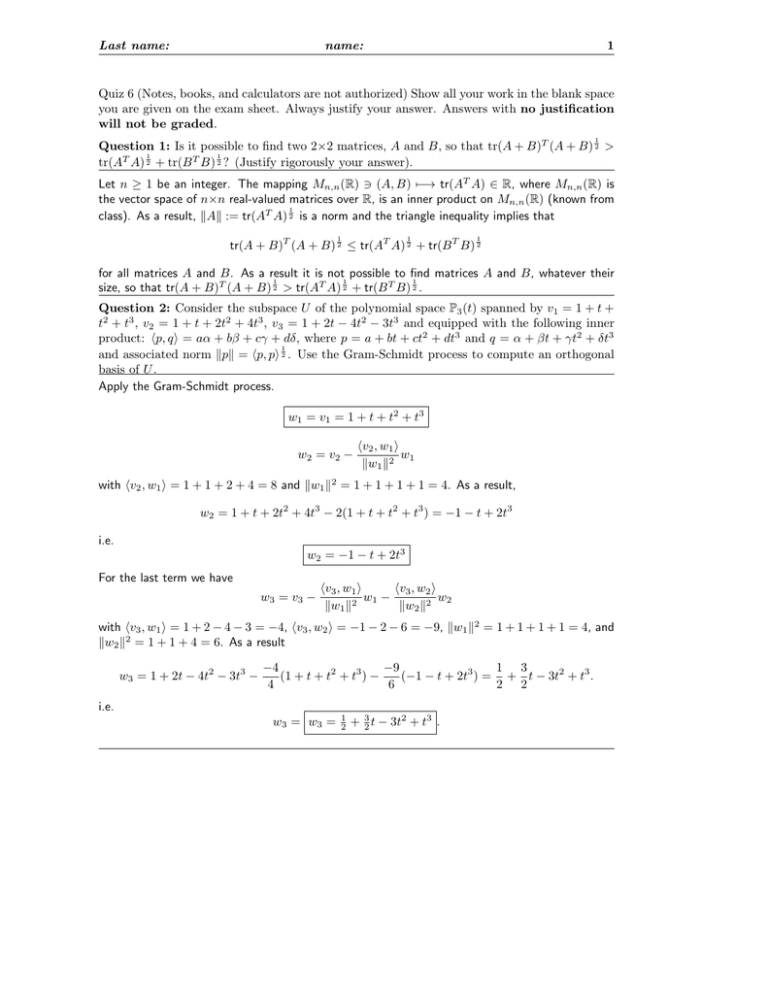
Last name:
name:
1
Quiz 6 (Notes, books, and calculators are not authorized) Show all your work in the blank space
you are given on the exam sheet. Always justify your answer. Answers with no justification
will not be graded.
1
Question 1: Is it possible to find two 2×2 matrices, A and B, so that tr(A + B)T (A + B) 2 >
1
1
tr(AT A) 2 + tr(B T B) 2 ? (Justify rigorously your answer).
Let n ≥ 1 be an integer. The mapping Mn,n (R) 3 (A, B) 7−→ tr(AT A) ∈ R, where Mn,n (R) is
the vector space of n×n real-valued matrices over R, is an inner product on Mn,n (R) (known from
1
class). As a result, kAk := tr(AT A) 2 is a norm and the triangle inequality implies that
1
1
1
tr(A + B)T (A + B) 2 ≤ tr(AT A) 2 + tr(B T B) 2
for all matrices A and B. As a result it is not possible to find matrices A and B, whatever their
1
1
1
size, so that tr(A + B)T (A + B) 2 > tr(AT A) 2 + tr(B T B) 2 .
Question 2: Consider the subspace U of the polynomial space P3 (t) spanned by v1 = 1 + t +
t2 + t3 , v2 = 1 + t + 2t2 + 4t3 , v3 = 1 + 2t − 4t2 − 3t3 and equipped with the following inner
product: hp, qi = aα + bβ + cγ + dδ, where p = a + bt + ct2 + dt3 and q = α + βt + γt2 + δt3
1
and associated norm kpk = hp, pi 2 . Use the Gram-Schmidt process to compute an orthogonal
basis of U .
Apply the Gram-Schmidt process.
w1 = v1 = 1 + t + t2 + t3
w2 = v2 −
hv2 , w1 i
w1
kw1 k2
with hv2 , w1 i = 1 + 1 + 2 + 4 = 8 and kw1 k2 = 1 + 1 + 1 + 1 = 4. As a result,
w2 = 1 + t + 2t2 + 4t3 − 2(1 + t + t2 + t3 ) = −1 − t + 2t3
i.e.
w2 = −1 − t + 2t3
For the last term we have
w3 = v3 −
hv3 , w1 i
hv3 , w2 i
w1 −
w2
kw1 k2
kw2 k2
with hv3 , w1 i = 1 + 2 − 4 − 3 = −4, hv3 , w2 i = −1 − 2 − 6 = −9, kw1 k2 = 1 + 1 + 1 + 1 = 4, and
kw2 k2 = 1 + 1 + 4 = 6. As a result
w3 = 1 + 2t − 4t2 − 3t3 −
−4
−9
1 3
(1 + t + t2 + t3 ) −
(−1 − t + 2t3 ) = + t − 3t2 + t3 .
4
6
2 2
i.e.
w3 = w3 =
1
2
+ 23 t − 3t2 + t3 .
2
Quiz 6, October 25, 2012
Question 3: Let (V, h·, ·i) be a finite-dimensional inner product space over R. Is it possible to
find a linear mapping F : V −→ V that has the following property: hF (v), vi ≥ 2kvk2 + 1 for
all vectors v in V ? Justify rigorously your answer.
Since F is linear, F (0) = 0. Then if F satisfies the property in question, one infers that hF (0), 0i ≥
2k0k2 + 1, i.e. 0 ≥ 1, which is absurd. In conclusion, no linear mapping can satisfy the property in
question.
Question 4: Let p0 = 1, p1 = x, p2 = 12 (3x2 − 1), p3 = 31 (5x3 − 3x) be the first four Legendre
polynomials. Recall that
R +1these polynomials form an orthonormal basis of P3 equipped with the
inner product hp, qi = −1 p(x)q(x)dx. Let u0 = p0 + p1 , u1 = p1 + p2 , u2 = p2 + p3 . Compute
hui , uj i for i 6= j, i, j ∈ {0, 1, 2}:
We compute hui , uj i for i 6= j, i, j ∈ {0, 1, 2}:
hu0 , u1 i = hp1 , p1 i = 1,
hu0 , u2 i = 0
hu1 , u2 i = hp2 , p2 i = 1,
This proves the statement.
(b) Compute ku0 k, ku1 k, ku2 k.
Since {p0 , p1 , p2 , p3 } is an orthonormal set, we can apply Pythagoras’ Theorem
ku0 k2 = 1 + 1 = 2,
thereby giving
ku0 k =
√
ku1 k2 = 1 + 1 = 2,
2,
ku1 k =
√
2,
ku2 k2 = 1 + 1 = 2,
ku2 k =
√
2.




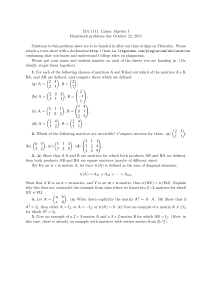

![MA3421 (Functional Analysis 1) Tutorial sheet 6 [November 13, 2014] Name: Solutions](http://s2.studylib.net/store/data/010731564_1-ca6ef076d1452b17ba4ab2c650a3f867-300x300.png)
